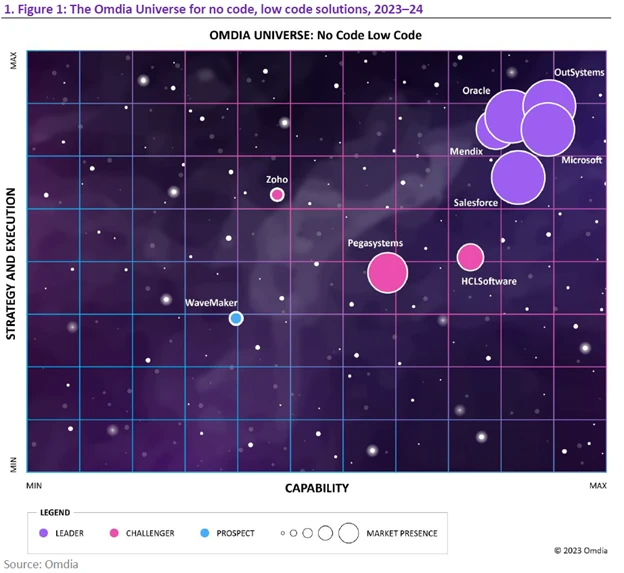Microsoft Power Apps named a No-Code/Low-Code Market Leader by Omdia

We’re excited to announce that Microsoft has been named a Leader in the Omdia Universe: No-Code, Low-Code Solutions 2023-2024 (download the report). Power Apps is in a leading position thanks to its technological capabilities, market reach, and momentum. The Power Apps team is thrilled to see Omdia cite our investment in AI and our strategic partnership with OpenAI.
“The infusion of AI-based Copilot into the Power Platform has had a dramatic impact on the market, accelerating the way developers work.”
Michael Azoff, Chief Analyst, Omdia
As the Omdia report states, Microsoft’s close integration of Microsoft Copilot across the whole Microsoft Power Platform allows makers to use generative AI to create apps, automations, web pages, and custom copilots, all of which have continuous updates.
Power Apps meets the needs of both citizen and professional developers, offering a wide range of features for novice makers and accelerating the productivity of professional developers.
“The solution [Power Apps] is designed to provide the whole range of NCLC (no-code, low-code) development experiences, from simple applications built by citizen makers requiring no-code development to tech-savvy makers and professional developers.”
Michael Azoff, Chief Analyst, Omdia
Power Apps helps build solutions—no matter who builds them
Power Apps enables professional developers to accelerate application development through visual tools and higher levels of abstraction. With its intuitive interface, developers can easily design applications, define data models, and implement business logic without diving deep into traditional code—unless it’s needed or preferred for specific extensibility scenarios. This streamlines development and reduces time-to-market.
Also, developers can build on a low-code platform that seamlessly integrates with Microsoft Azure services, meaning they can harness the power of Azure functions, application programming interfaces (APIs), and other services directly within their Power Apps solutions. It’s a win-win for both productivity and scalability. The Power Apps component framework empowers developers to create reusable code components for both model-driven and canvas apps. These components enhance the user experience by adding custom functionality to forms, views, dashboards, and canvas app screens.
Finally, Power Apps makes it easy to create connectors to custom or legacy systems. Developers can integrate their apps with existing data sources, whether on-premises or in the cloud. This flexibility ensures that Power Apps can fit into organizations’ ecosystems with ease.
Custom apps widely available
For citizen developers, Power Apps empowers them to create custom applications without extensive coding expertise. They can visually design user interfaces, define data models, and implement business logic without the need for intricate programming skills. The intuitive drag-and-drop features enable them to assemble components, connect to data sources, and create functional workflows. This agility accelerates the development cycle for organizations, allowing for quick iterations and adjustments.
Power Apps encourages collaboration within organizations where citizen developers work alongside traditional developers and IT professionals, sharing knowledge and best practices. Nsure.com, a licensed digital insurance agency, uses fusion approach for updating and building applications. By empowering employees to build their own solutions, organizations tap into a wealth of creativity and domain expertise.
“During early development, we had new builds rolling out every week, often comprising hundreds of updates. The same functionality would have taken us two to three times longer using traditional code.”
Wojtek Gudaszewski, co-founder of Nsure.com
Governance and control—whether for ten apps or ten thousand apps
Effective governance ensures that organizations can harness the potential of Power Apps while maintaining control and compliance. Power Apps as part of Microsoft Power Platform benefits from robust governance and security and provides admins tools for granular control over roles and permissions, defining roles, and assigning specific permissions based on business needs.
Power Apps provides access control with licenses, admin connectors, data loss prevention policies, and environment roles. Multi-factor authentication, data encryption, and active monitoring are other ways in which Power Apps empowers organizations by striking a balance between innovation and control.
“The main purpose of what we do is to make Power Platform secure so that people can build applications that simplify their own work.”
Andy Kunz, Global IT Solution Architect, Zurich Insurance
We’re thrilled to be recognized in the Omdia Universe report and we are grateful to all the customers, partners and community who’ve joined us on this journey.
Read and download the Omdia report.



